Muscularis externa - Samenvattingen, Notities en Examens
Op zoek naar een samenvatting over Muscularis externa? Op deze pagina vind je 220 samenvattingen over Muscularis externa.
Pagina 4 van de 220 resultaten
Sorteer op
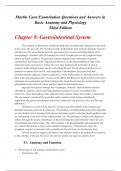
-
Chapter 9: Gastrointestinal System Martin Caon Examination Questions and Answers in Basic Anatomy and Physiology Third Edition
- Tentamen (uitwerkingen) • 38 pagina's • 2023
-
Ook in voordeelbundel
-
- €6,99
- + meer info
Martin Caon Examination Questions and Answers in Basic Anatomy and Physiology Third Edition Chapter 9: Gastrointestinal System 9.1 Anatomy and Function 1. Which type of cell produces hydrochloric acid? a. Zymogenic cells b. Parietal cells c. Chief cells d. Enteroendocrine cells Answer is B: The parietal cells of gastric glands produce hydrochloric acid. (Zymogenic cells are the same as chief cells, and they produce pepsinogen.) 2. What is the role of gastrin in the digestive ...
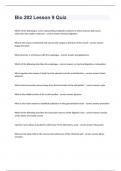
-
Bio 202 Lesson 9 Quiz well answered to pass
- Tentamen (uitwerkingen) • 3 pagina's • 2024
-
Ook in voordeelbundel
-
- €9,46
- + meer info
Bio 202 Lesson 9 Quiz well answered to pass Which of the following is a term representing metabolic reactions in which enzymes split macro molecules into smaller molecules - correct answer Chemical digestion What is the mucous membrane that secures the tongue to the floor of the mouth - correct answer lingual frenulum What structure is continuous with the esophagus - correct answer laryngopharynx Which of the following describes the esophagus - correct answer no chemical digestion or a...
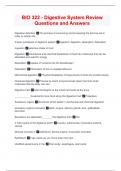
-
BIO 322 - Digestive System Review Questions and Answers
- Tentamen (uitwerkingen) • 6 pagina's • 2024
-
Ook in voordeelbundel
-
- €8,99
- + meer info
Digestion definition The process of consuming and processing the food we eat in order to sustain life 4 basic processes of digestive system Ingestion, digestion, absorption, defecation Ingestion selective intake of food Digestion mechanical and chemical breakdown of food into molecules that can be absorbed and used for energy Absorption Uptake of nutrients into the bloodstream Defecation Elimination of the un-useable leftovers Mechanical digestion Physical breakdown of large pieces of food...
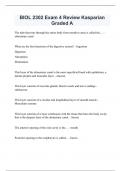
-
BIOL 2302 Exam 4 Review Kasparian Graded A
- Tentamen (uitwerkingen) • 40 pagina's • 2024
-
- €12,78
- + meer info
The tube that runs through the entire body from mouth to anus is called the.... - alimentary canal What are the four functions of the digestive system? - Ingestion Digestion Absorption Elimination This layer of the alimentary canal is the most superficial lined with epithelium, a lamina propria and muscular layer. - mucosa This layer consists of exocrine glands, blood vessels and nerve endings - submucosa This layer consists of a circular and longitudinal layer of smooth muscle. -...
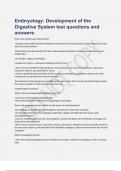
-
Embryology Development of the Digestive System test questions and answers
- Tentamen (uitwerkingen) • 6 pagina's • 2024
-
- €13,72
- + meer info
How is the primitive gut tube formed? -through craniocaudal and lateral folding of the embryo via the incorporation of the dorsal part of the yolk sac into the embryo The primitive gut tube extends from the oropharyngeal membrane to the cloacal membrane and is divided into... -the foregut, midgut, and hindgut Compare the adult vs. embryonic histology of the GI tract. -adult: mucosa (epithelial lining and glands, lamina propria, and muscularis mucosae), submucosa, muscularis externa,...
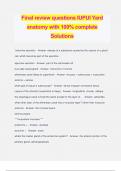
-
Final review questions IUPUI Yard anatomy with 100% complete Solutions
- Tentamen (uitwerkingen) • 4 pagina's • 2024
-
Ook in voordeelbundel
-
- €9,94
- + meer info
Final review questions IUPUI Yard anatomy with 100% complete Solutions holocrine secretion - Answer- release of a substance caused by the rupture of a gland cell, which becomes part of the secretion apocrine secretion - Answer- part of the cell breaks off true salty sweat gland - Answer- merocrine or eccrine alimentary canal (deep to superficial) - Answer- mucosa > submucosa > muscularis externa > serosa what type of tissue is submucosa? - Answer- dense irregular connective tis...
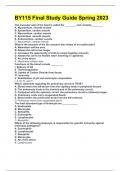
-
BY115 Final Study Guide Spring 2023
- Tentamen (uitwerkingen) • 21 pagina's • 2023
-
- €10,88
- + meer info
BY115 Final Study Guide Spring 2023 The muscular wall of the heart is called the ________ and contains________ A. Myocardium, smooth muscle B. Epicardium, cardiac muscle C. Myocardium, cardiac muscle D. Epicardium, smooth muscle E. Endocardium, cardiac muscle C. Myocardium, cardiac muscle What is the purpose of the bio concave disc shape of an erythrocyte? A. Maximizes surface area B. Allows the cell to live longer C. Increases the opportunity of cells to clump together prevents D...
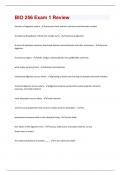
-
BIO 256 Exam | 68 Questions and Answers(A+ Solution guide)
- Tentamen (uitwerkingen) • 6 pagina's • 2023
-
- €3,31
- + meer info
function of digestive system - processes food, extracts nutrients and eliminates residue the physical breakdown of food into smaller parts - mechanical digestion A series of hydrolysis reactions that break dietary macromolecules into their monomers - chemical digestion 6 accessory organs - teeth, tongue, salivary glands, liver, gallbladder, pancreas what makes up the gi tract - stomach and intestines mechanical digestion occurs where - grinding of teeth and churning of stomach and small in...
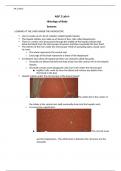
-
A&P 2 Lab 6- Histology of Body Systems
- Tentamen (uitwerkingen) • 12 pagina's • 2023
-
- €9,46
- + meer info
A&P 2 Lab 6- Histology of Body Systems LOOKING AT THE LIVER UNDER THE MICROSCOPE • Liver is made up of a lot of cylinders called Hepatic lobules. • The hepatic lobules are made up of sheets of liver cells called Hepatocytes • There is a center vein that passes through the middle of the hepatic lobules that drain the blood from the microscopic structures and then eventually the liver itself. • The interior of the liver under the microscope- think of spreading open a book cover to cov...
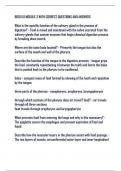
-
BIOD 151 MODULE 3 WITH CORRECT QUESTIONS AND ANSWERS
- Tentamen (uitwerkingen) • 10 pagina's • 2024
-
Ook in voordeelbundel
-
- €19,79
- + meer info
BIOD 151 MODULE 3 WITH CORRECT QUESTIONS AND ANSWERS What is the specific function of the salivary gland in the process of digestion? - Food is mixed and moistened with the saliva secreted from the salivary glands that contain enzymes that begin chemical digestion process by breaking down starch. Where are the taste buds located? - Primarily the tongue but also the surface of the mouth and wall of the pharynx. Describe the function of the tongue in the digestive process - tongue gri...

Studiestress? Voor verkopers op Stuvia zijn dit juist gouden tijden. KA-CHING! Verdien ook aan je samenvattingen en begin nu met uploaden. Ontdek alles over verdienen op Stuvia


